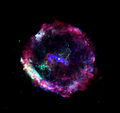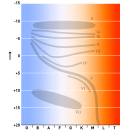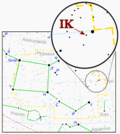shell, producing a super-luminous supernova. Ultra-stripped supernovae occur when the exploding star has been stripped (almost) all the way to the metal...
201 KB (21,932 words) - 18:45, 9 September 2024
Common envelope jets supernova (CEJSN) is a type of supernova, where the explosion is caused by the merger of a giant or supergiant star with a compact...
12 KB (1,661 words) - 18:01, 17 July 2024
March 2023, a third supernova appeared in this galaxy: SN 2023dbc (Type Ic, mag. 17). 2023dbc is likely a stripped-envelope supernova as there is no evidence...
9 KB (1,069 words) - 00:43, 4 October 2024
Type Ib and Ic supernovae (redirect from Type Ib supernova)
initial envelope, including most of their helium. The two types are usually referred to as stripped core-collapse supernovae. When a supernova is observed...
13 KB (1,521 words) - 16:41, 24 August 2024
Re'im music festival massacre (redirect from Supernova Sukkot festival massacre)
Israel from the Gaza Strip. As part of the attack, 364 individuals, mostly civilians, were killed and many more wounded at the Supernova Sukkot Gathering...
106 KB (9,078 words) - 12:00, 5 October 2024
SN 386 (section Suggested as supernova)
; Roberts, M.S.E. (2016). "G11.2-0.3: the young remnant of a stripped-envelope supernova". Astrophysical Journal. 819 (2): 160. arXiv:1602.03531. Bibcode:2016ApJ...
10 KB (1,238 words) - 01:50, 9 August 2024
mass loss. Such a star will still have a hydrogen envelope and will explode as a Type II supernova. Faint Type II supernovae have been observed, but no...
24 KB (2,578 words) - 14:28, 6 September 2024
and Ic supernovae are a type of core-collapse supernova for a massive star that has shed its outer envelope of hydrogen and (for Type Ic) helium. As a result...
49 KB (4,792 words) - 00:40, 25 August 2024
A Type Ia supernova (read: "type one-A") is a type of supernova that occurs in binary systems (two stars orbiting one another) in which one of the stars...
48 KB (5,057 words) - 04:49, 19 July 2024
Stellar evolution (section Supernova)
mass so rapidly due to radiation pressure that they tend to strip off their own envelopes before they can expand to become red supergiants, and thus retain...
50 KB (6,476 words) - 21:57, 11 September 2024
A hypernova is a very energetic supernova which is believed to result from an extreme core collapse scenario. In this case, a massive star (>30 solar...
20 KB (2,210 words) - 12:44, 25 August 2024
luminosity (much like that of type II-P supernova) powered by the recombination of hydrogen in the envelope. After that the luminosity should decrease...
10 KB (1,104 words) - 18:20, 25 February 2024
White dwarf (section Post-common envelope binary)
A close candidate to being a survivor of a type Ia supernova is WD 0810-353. A post-common envelope binary (PCEB) is a binary consisting of a white dwarf...
153 KB (17,798 words) - 02:27, 20 September 2024
Supergiant (section Supernova progenitors)
an iron core, at which point the core collapses to produce a Type II supernova. Once these massive stars leave the main sequence, their atmospheres inflate...
39 KB (5,371 words) - 18:49, 20 July 2024
to the drop in brightness after the initial supernova peak, the characteristic of a Type II-P supernova. The most luminous red supergiants, at near solar...
33 KB (4,233 words) - 03:21, 23 July 2024
whereas binary stars undergo much-more-complex evolution through envelope stripping leading to less predictable outcomes. Luminous blue variable stars...
39 KB (4,826 words) - 08:01, 1 September 2024
the collapsed core of a massive supergiant star. It results from the supernova explosion of a massive star—combined with gravitational collapse—that...
114 KB (13,815 words) - 14:26, 26 September 2024
observe and write about a supernova, now known as SN 185. The brightest stellar event in recorded history was the SN 1006 supernova, which was observed in...
147 KB (16,412 words) - 12:11, 7 September 2024
from the collapse of stars with unusually strong magnetic fields. In a supernova, a star collapses to a neutron star, and its magnetic field increases...
31 KB (3,266 words) - 15:13, 30 August 2024
Eta Carinae (section Potential supernova)
comparable to other supernova impostors detected in external galaxies. It does not currently lie on the S Doradus instability strip, although it is unclear...
125 KB (14,963 words) - 02:53, 8 September 2024
undergoing fusion forming helium (known as hydrogen burning), and a very large envelope of material of composition similar to main-sequence stars (except in the...
26 KB (3,220 words) - 02:09, 4 October 2024
expanded gaseous envelope. When the white dwarf approaches the Chandrasekhar limit of 1.4 solar masses (M☉), it may explode as a Type Ia supernova. This star...
46 KB (5,202 words) - 04:42, 23 August 2024
A circumstellar envelope (CSE) is a part of a star that has a roughly spherical shape and is not gravitationally bound to the star core. Usually circumstellar...
2 KB (198 words) - 07:50, 1 October 2023
goes supernova. Because no supernova is perfectly symmetric, and because the binding energy of the binary changes with the mass lost in the supernova, the...
17 KB (1,696 words) - 21:02, 15 August 2024
is a Type Ic supernova discovered in 2022 in the spiral galaxy NGC 157 at a distance of about 23 Mpc. The light curve of the supernova exhibited oscillations...
8 KB (572 words) - 01:56, 9 August 2024
Supernova impostors are stellar explosions that appear at first to be a supernova but do not destroy their progenitor stars. As such, they are a class...
4 KB (410 words) - 17:15, 12 August 2023
It is speculated that some massive black dwarfs may eventually produce supernova explosions. These will occur if pycnonuclear (density-based) fusion processes...
10 KB (1,142 words) - 05:00, 25 July 2024
and strips the companion star of its hydrogen envelope, turning it into a helium star.: 5788 The helium star eventually explodes in an ultra-stripped supernova...
20 KB (2,123 words) - 16:15, 18 July 2024
Stellar structure (redirect from Hydrogen envelope)
transparent to ultraviolet radiation. Thus, massive stars have a radiative envelope. The lowest mass main sequence stars have no radiation zone; the dominant...
15 KB (2,089 words) - 21:20, 1 October 2024
may have a companion star that stripped its outer envelope. It is widely suspected that many type Ib and type Ic supernova progenitors are WR stars, although...
96 KB (10,604 words) - 08:29, 11 September 2024
























